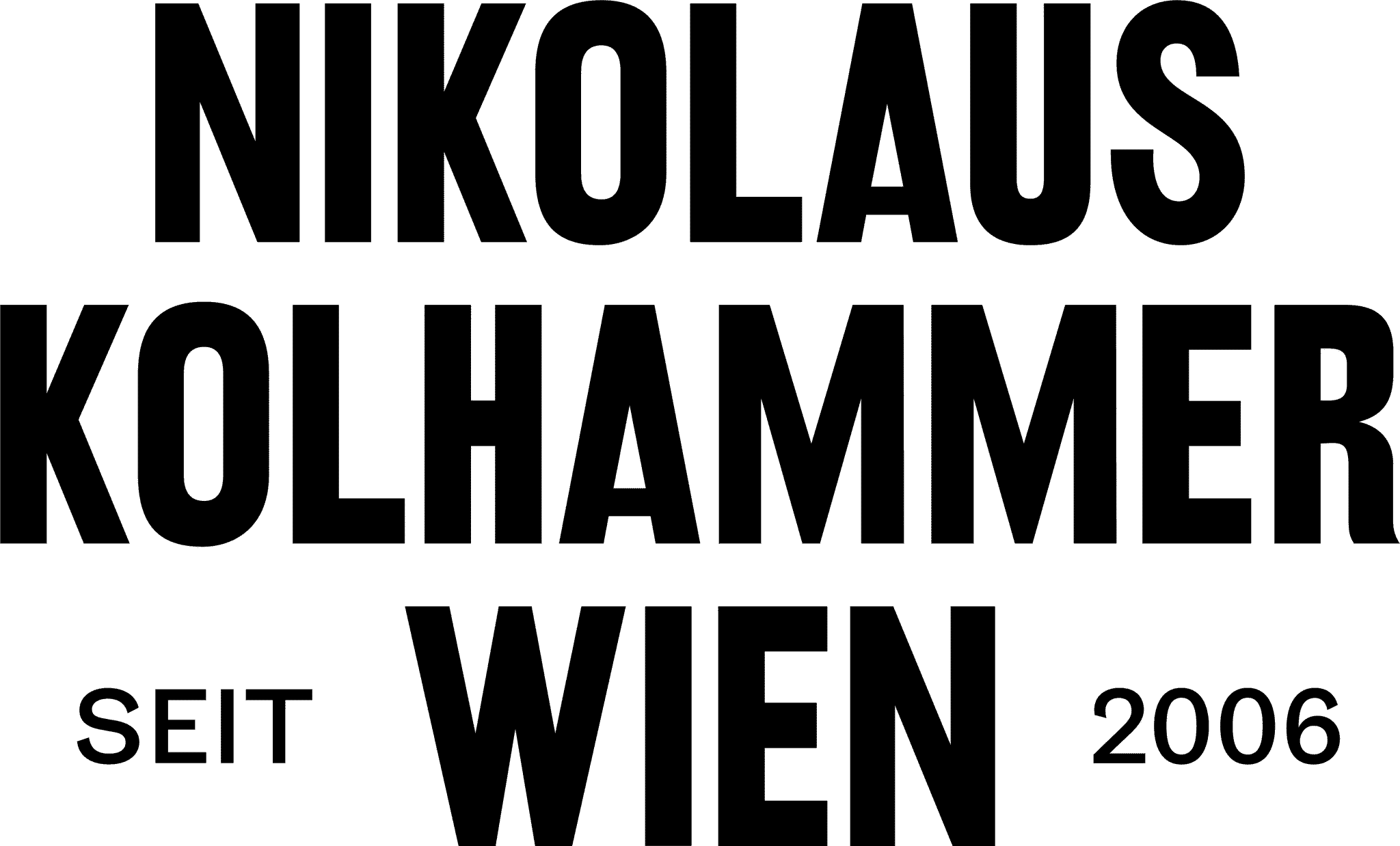HIGHLIGHTS
Highlights & Masterpieces
In this section, we showcase selected highlights and significant works from our collection of recent years. These include outstanding pieces from the Wiener Werkstätte, rare creations by the Loetz glassworks, and icons of Austrian design. Some of these works are already part of renowned collections—testament to their artistic and historical significance.

Mantle clock Josef Hoffmann 1903
Wiener Werkstätte
The mantel clock is one of Josef Hoffmann’s earliest designs for the Wiener Werkstätte. Produced only twice—in 1903, the founding year of the Werkstätte—it is notable not only for its rarity but also for its profound historical significance. The two known examples, one in silvered copper and the other in patinated copper, were sold to two prominent Viennese families closely associated with Hoffmann and the Wiener Werkstätte: the Kohn and Spitzer families.
This particular piece comes from the collection of the Spitzer family, for whom Hoffmann had already designed and furnished a villa in the Hohe Warte residential colony in 1900. Made of patinated copper, the clock features finely chased and hammered details, with its original patina beautifully preserved. The design is further refined by eight alabaster columns, a dial made of alpaca with enameled numerals, faceted and cut glass, and a capital adorned with a gemstone.
By 1906, the clock had already gained international recognition when it was featured in The Art-Revival in Austria.

Franz Hofstötter for the world exhibition Paris 1900
Johann Loetz Witwe
Undoubtedly, this 47 cm tall vase ranks among the most important pieces ever produced by the Johann Loetz Witwe Glassworks. Both its form and decoration were created by Franz Hofstötter, who designed it on behalf of the Loetz company for the 1900 Paris Exposition Universelle.
The realization of this exceptionally intricate decorative concept at such an impressive scale posed a remarkable challenge—even for the highly skilled master glassblowers of Loetz. The so-called Phänomen Genre 387, known as “Pink with Silver,” was developed specifically for this form, as evidenced by the identical numbering of the design pattern and the decoration.
Typical of Hofstötter’s work is the symbolist and strongly naturalistic treatment of the vase’s surface. The dark brown base may be interpreted as a symbol of earth, while the body—wrapped in bluish and silvery-yellow glass threads—represents the atmosphere or air. The orange-red rim symbolizes the element of fire. Thus, the vase not only combines formal sophistication with technical brilliance but also conveys conceptual depth: a poetic interpretation of the four classical elements—captured in iridescent glass.
This vase was among the most valuable exhibits that Loetz presented at the Paris World’s Fair. With its innovative decoration and superb craftsmanship, the glassworks achieved international acclaim. In recognition, it was awarded the Grand Prix—the exposition’s highest honor.

Emil Nolde Pansies ("Stiefmütterchen") 1908
Fine Art
Throughout his life, Emil Nolde returned again and again to the depiction of flowers. Rather than painting arranged still lifes of flowers in vases, he found his inspiration directly in his own gardens. From 1903 onward, he lived with his wife Ada in a fisherman’s cottage on the Danish island of Alsen, where the couple cultivated their own flower garden. Reflecting on this period, Nolde recalled:
“The colors of the flowers attracted me irresistibly, and almost suddenly I was painting. My first small garden pictures emerged. The blooming colors of the flowers and the purity of those colors—I loved them. I loved the flowers in their fate: bursting upward, blooming, glowing, blazing, joyful, bending, wilting […]”
— (quoted from Emil Nolde, Jahre der Kämpfe, Cologne 1985, p. 100)
During his time in Alsen, Nolde created the painting Pansies. He chose a tight composition to explore the emotional power of color. Using dynamic, spontaneous brushstrokes, he applied thick, luminous blues, violets, and yellows whose intense expressiveness recalls his involvement with the artist group Die Brücke.

Pair of candlesticks "Leon" Franz Hagenauer ca. 1925
Werkstätte Hagenauer Wien
In the final semester of his studies at the School of Applied Arts, Franz Hagenauer was involved in preparations for the 1925 Paris World’s Fair, the Exposition Internationale des Arts Décoratifs et Industriels Modernes. Under the direction of his teacher Anton Hanak, Hagenauer and four fellow students created works for a space designated by the organizers as the salle de culte (“room of worship”). This devotional room, lined with chased metal panels, featured numerous wall reliefs and metal sculptures, including an equestrian figure by Hagenauer. For his contribution, the 19-year-old artist was awarded a silver medal. Historic photographs of the room reveal a design reminiscent of a Romanesque portal, with subtle references to Christian iconography. Later that same year, Hagenauer exhibited additional works at the Vienna Secession’s exhibition of Christian art. These included a chased reliquary, an Easter candlestick, and a Holy Spirit dove, all stylistically linked to his earlier contributions to the salle de culte.
The Leon candlestick pair likely originated in the context of these two exhibitions. Sculptural in form and crafted from hammered brass, the candlesticks depict highly stylized, simplified figures that echo those found in the reliefs of the worship room. However, their original symbolic meaning gives way to a more ornamental composition. Here, Hagenauer employs a technique that would later become characteristic of the Werkstätte Hagenauer: arranging figures in rhythmic, decorative groupings and using deliberate asymmetry to create a sense of movement and vitality.
The Leon candlesticks were photographed alongside a bowl in 1928 for the Werkstätte Hagenauer sales catalog and are also recorded as sketches in the workshop’s pattern book. The detailed match between these candlesticks and those shown in the historical photograph supports the assumption that they were produced only once.
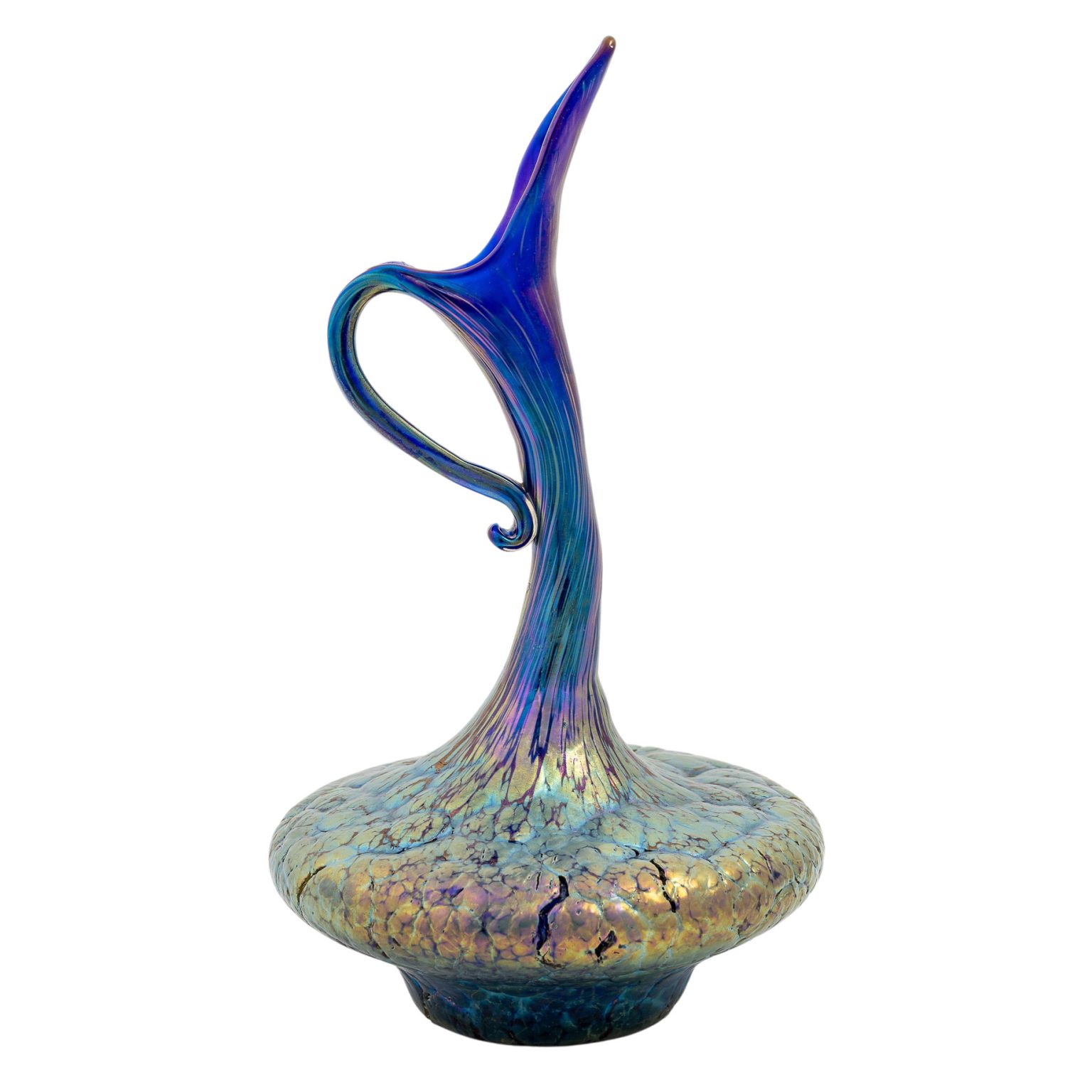
Franz Hofstötter for the world exhibition Paris 1900
Johann Loetz Witwe
Our vase is one of thirteen confirmed designs that Franz Hofstötter created on commission for the glass manufactory Johann Loetz Witwe for the 1900 Paris World’s Fair. Its extraordinary decoration, known as Phänomen Genre 377, was also unveiled to the public for the first time at this exhibition. The cracked, uneven surface was a bold departure both aesthetically and tactilely from previous decorative styles and quickly became an immensely popular motif in the years that followed. A historic photograph documents this model at the 1900 Paris World’s Fair.
The glassware series produced by the Loetz manufactory for the World’s Fair remains among the most fascinating objects for Loetz collectors. Its decorations are considered some of the most beautiful and technically complex ever created by Loetz.
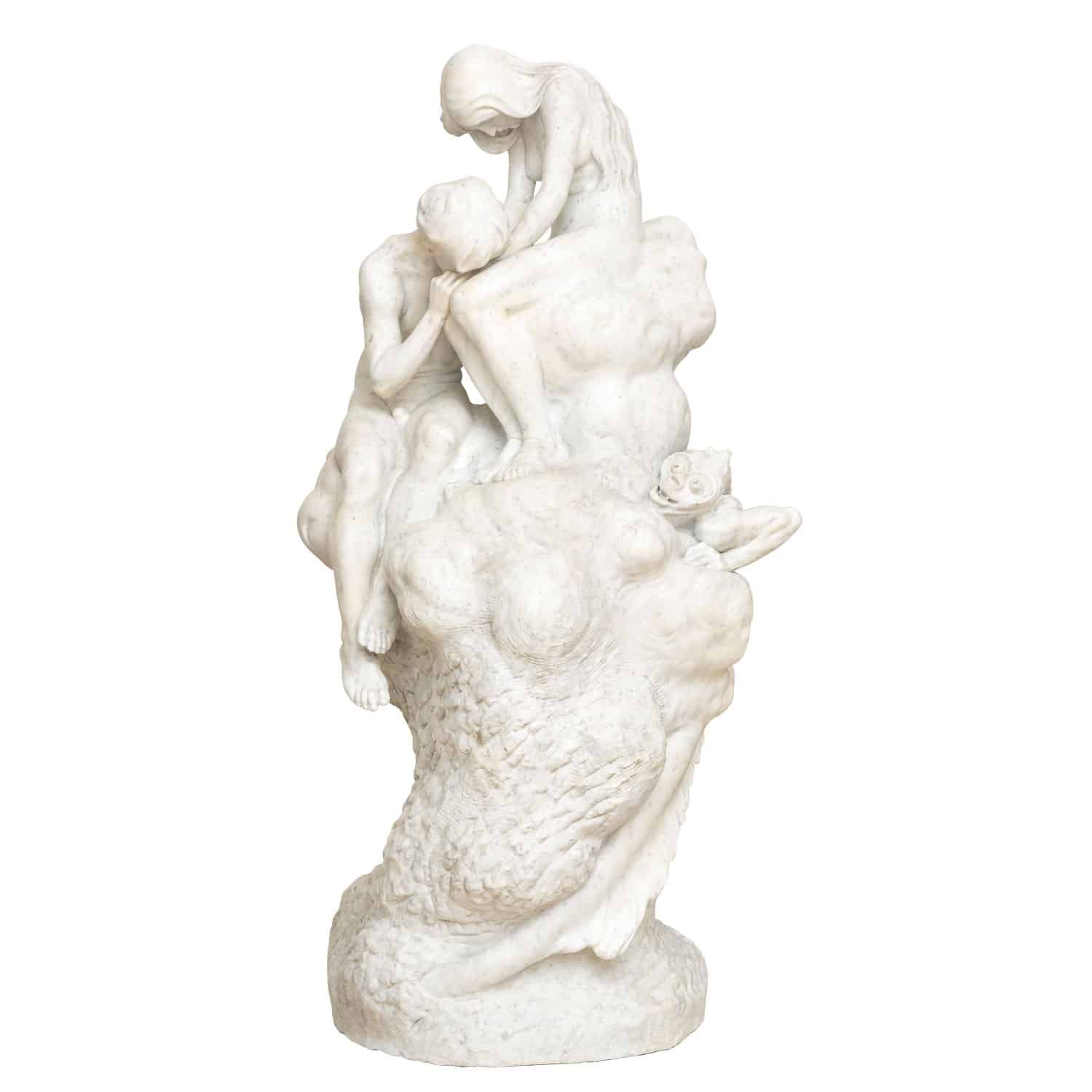
Monumental marble sculpture "Love and Envy" 1900
Gustav Gurschner
Gustav Gurschner’s Love and Envy is a notable example of early Viennese Modernism. Gurschner was a founding member of the Vienna Secession and an early member of the Vienna Hagenbund. He created this sculpture in 1900, shortly after returning from Paris, carving it from Carrara marble in his studio on Lindengasse. Inspired and artistically energized by his travels, he aimed to craft a monumental sculpture in the distinctive Viennese style. In doing so, he achieved something outstanding and of significant art-historical importance.
The execution and meticulous detail of the sculpture can rightly be described as masterful. Before working on the marble statue, he developed the proportions in a plaster study—also in my possession—which served as the working model for the final piece. Love and Envy was exhibited in the main room at the opening exhibition of the Vienna Hagenbund. Gurschner took immense pride in Love and Envy; both the model and a large framed photograph remained in his studio on Lindengasse until its closure.

Piano Player Franz Hagenauer ca. 1978
Werkstätte Hagenauer Wien
The Pianist, crafted in nickel-plated brass around 1970, is a quintessential work by Franz Hagenauer and stands among the most striking examples of his late creative period.
With remarkable skill, Hagenauer reduces a dynamic, lifelike scene to its essential elements, translating it into a flat, almost two-dimensional visual language—a stylistic hallmark of the Werkstätte Hagenauer’s later phase.
This life-sized sculpture captivates not only through its formal clarity but also through its commanding presence: standing over 160 cm tall, the pianist evokes the aura of a stage performer—distinguished by poise, elegance, and expressive force.
Dressed in stylized evening attire—accentuated by sculptural metal appliqués and fine chasing—the figure is rendered with both richness and refinement. Details such as the precisely tied bow tie, the prominently modeled tuxedo collar, and the subtly indicated cufflinks imbue the work with a sense of vitality. With a keen eye for design and proportion, Franz Hagenauer captures the scene in a sharply contoured silhouette, combining abstraction with theatrical flair.
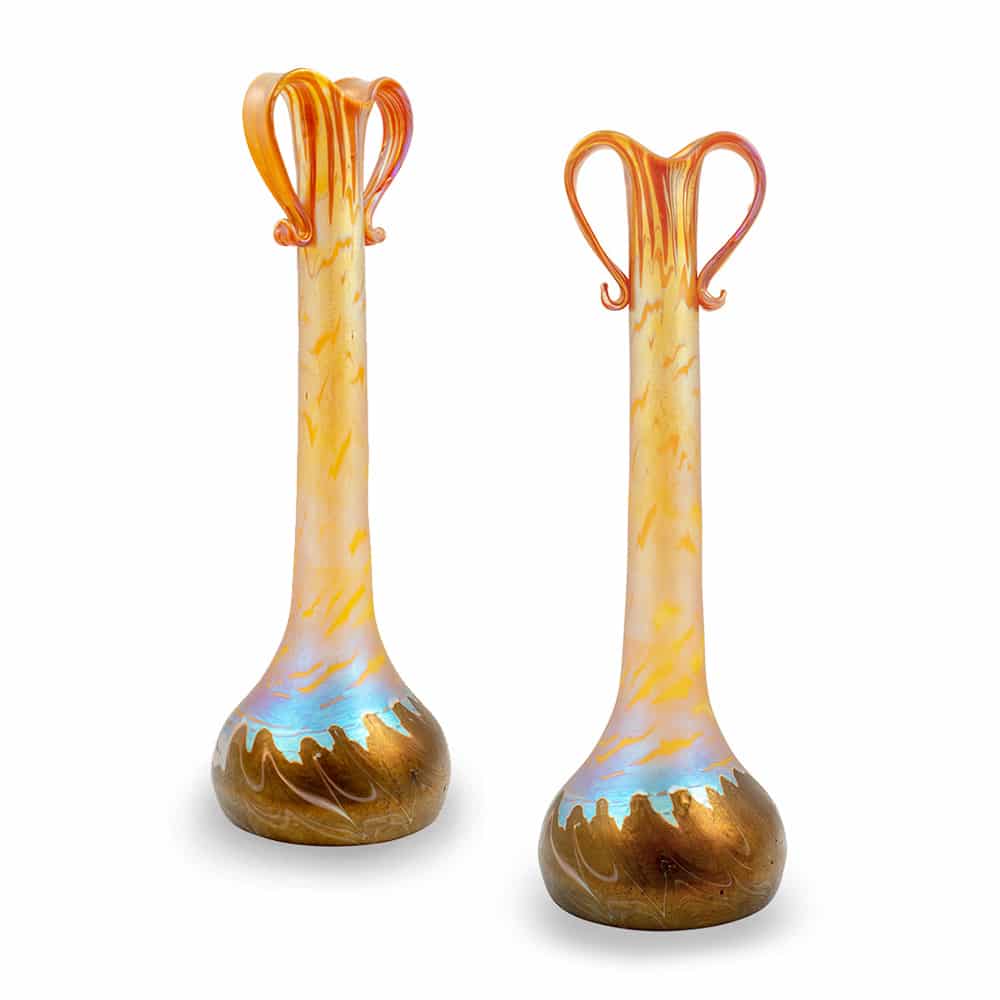
Pair of vases school of Koloman Moser Robert Holubetz
Johann Loetz Witwe
The World Exhibition in Paris in 1900 was a turning point in the Loetz company history. At this fair, the Loetz company was honored with the “Grand Prix”, the world’s highest award for arts and crafts. The Viennese painter Franz Hofstötter played a major role in the success of the company. It is thanks to his ingenious designs of forms and decorations that Loetz’s glasses were so enthusiastically received at the world exhibition. The design of this decoration variant has safely beeen matched to the pen of Franz Hofstötter. Examples of this decoration were also proven to have been exhibited at the World Exhibition in Paris in 1900 and at the winter exhibition of the ÖMKI in 1900/1901. Robert Holubetz, the most famous student of Koloman Moser, was responsible for the design of the shape. This vases represent an important chapter in the art-historical history of Austria and are a jewel for any glass collection.
- Franz Hofstötter and Robert Holubetz (school Koloman Moser)
- Decor Phenomenon Genre 358
- higned on the bottom Loetz Austria
- height 28,5cm, diameter 9cm

Complete Silver tea service Josef Hoffmann ca. 1918
Wiener Werkstätte
This rare tea service, designed around 1918 by Josef Hoffmann, ranks among the most striking examples of Viennese Werkstätte craftsmanship. At a time when precious metals and luxury materials such as ivory had become increasingly scarce, only two versions of this design are known to have been produced, according to the MAK—one in 1918 and another in 1920. The ivory remains undamaged, the silverwork is executed with masterful precision, and—remarkably—the ensemble is preserved in its entirety.
In keeping with the Wiener Werkstätte’s design philosophy of infusing everyday life with art and beauty, its artists and artisans created functional objects for all aspects of daily living. Josef Hoffmann was one of the movement’s most influential figures. His furniture, tableware, and especially his tea and coffee services are now regarded as icons of early 20th-century applied art.
Hoffmann’s tea and coffee services occupy a distinguished place in both private and museum collections. They exemplify not only his unmistakable, clean-lined aesthetic but also the exceptional craftsmanship for which the Wiener Werkstätte is renowned.

Egon Schiele Budweis gate in Cesky Krumlov 1908
Fine Art
The painting The Budweis Gate dates to 1908, a year that proved formative for Egon Schiele’s artistic development. It depicts a view of the city gate of the same name in Krumau—his mother’s birthplace and a town to which Schiele maintained a deep emotional connection throughout his life.
With broad, impasto brushstrokes and a palette reduced to just a few tones—dominated by shades of violet—the young artist imbues the scene with a distinctive expressive power. He deliberately left parts of the brown cardboard exposed, lending the composition a raw and immediate quality.
Even in this early work, Schiele’s remarkable sensitivity to form, color, and spatial composition is already evident—qualities that would later become hallmarks of his unmistakable style.

Chandelier with Loetz lampshades Koloman Moser 1901
Johann Loetz Witwe
This elegant pendant light exemplifies Koloman Moser’s distinctive design approach, combined with the exceptional craftsmanship of Viennese artisans around 1900. Created shortly before his co-founding of the Wiener Werkstätte, the piece offers a compelling insight into Moser’s early exploration of modern interior design.
The ceiling plate and decorative elements of this example are made of silvered brass and feature Moser’s signature hammered surface. The opal white glass globes—produced by the renowned glass manufacturer Loetz—are adorned with fused red spots, a striking illustration of Moser’s geometric and abstract decorative style.
Even before co-founding the Wiener Werkstätte in 1903, Moser designed a wide range of decorative objects for various Viennese firms—including lighting fixtures. As early as 1899, he created lamps for the esteemed glass and art dealer E. Bakalowits Söhne. In 1901, several so-called “Penden” (pendant lamps) were developed—suspended from ceiling plates by cords and enhanced with finely worked metal fittings.
These lights were conceived with remarkable flexibility: the size and shape of the ceiling plate, the number of light sources, and the decorative elements could all be customized. Moser himself used four-light versions of this type in his own apartment—documented in a photograph of his interiors published in 1906 in the esteemed journal Deutsche Kunst und Dekoration.
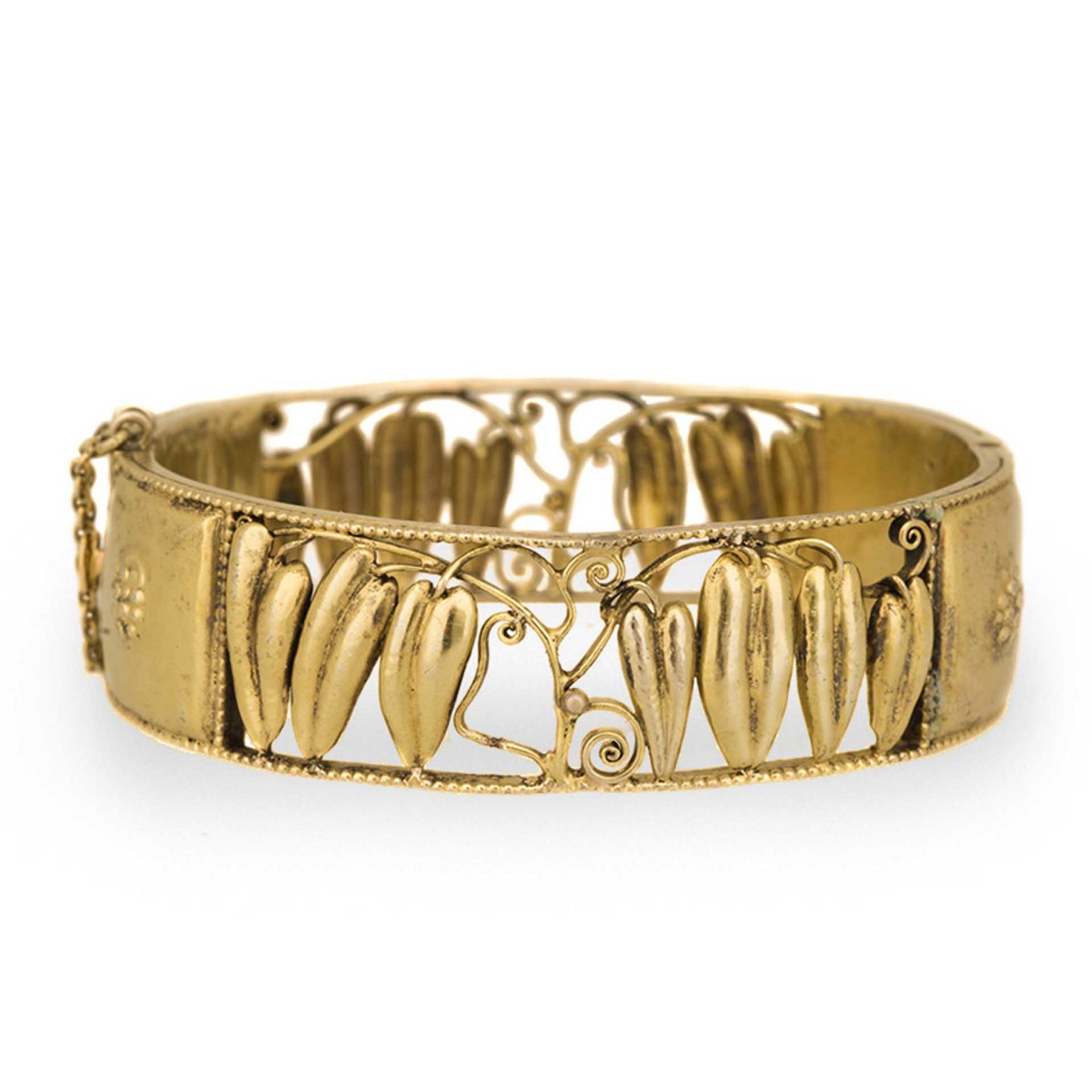
gold bracelet "blattwerk" Josef Hoffmann ca. 1910
Wiener Werkstätte
Today, jewellery objects of the Wiener Werkstätte are among the most expensive objects of Viennese Jugendstil and are extremely rare and in great demand. Especially bracelets take a special position. Few surviving examples can be found in museums today, more often in private ownership. In addition, there is a comparatively small number of this type of jewellery, as is impressively demonstrated in the archive of the Wiener Werkstätte in the Museum of Applied Arts: only 30 bracelets are published here by photograph, Josef Hoffmann is responsible for only 15 drafts as a designer.
- bracelet
- silver, gold plated
- driven and soldered
- around 1910.
- diameter 6 cm 2.4 “

Table lamp with Loetz-shade ca. 1900
Gustav Gurschner
This exceptional table lamp ranks among the most significant lighting designs created by Gustav Gurschner around 1900—an impressive example of the artistic fusion of sculpture and function in the spirit of Viennese Jugendstil.
Shortly after his acclaimed debut at the First Exhibition of the Vienna Secession in 1898, leading firms such as Johann Loetz Witwe and E. Bakalowits & Söhne began collaborating with Gurschner. His organically shaped designs were paired with high-quality glass shades from Austria’s finest glassworks.
The present lamp clearly reflects the influence of French Art Nouveau, which Gurschner encountered during a stay in Paris in 1897. Rising like a stylized plant stem, the bronze base curves upward in an elegant, flowing line, branching into finely detailed ornaments that lend the piece a distinctly sculptural character.
The composition is crowned by a delicately iridescent glass shade from the Loetz glassworks, executed in the Phänomen Genre 8065 décor. Silvery-gold threads course through the glass in intricate, dense patterns, tapering into delicate droplets along the upper rim. This shade imparts an almost ethereal elegance and casts a warm, atmospheric light.
With its perfect balance of artistic ambition, technical refinement, and decorative presence, this lamp is a masterpiece of Viennese Jugendstil—and a superb example of Gurschner’s contribution to the applied arts at the turn of the century.
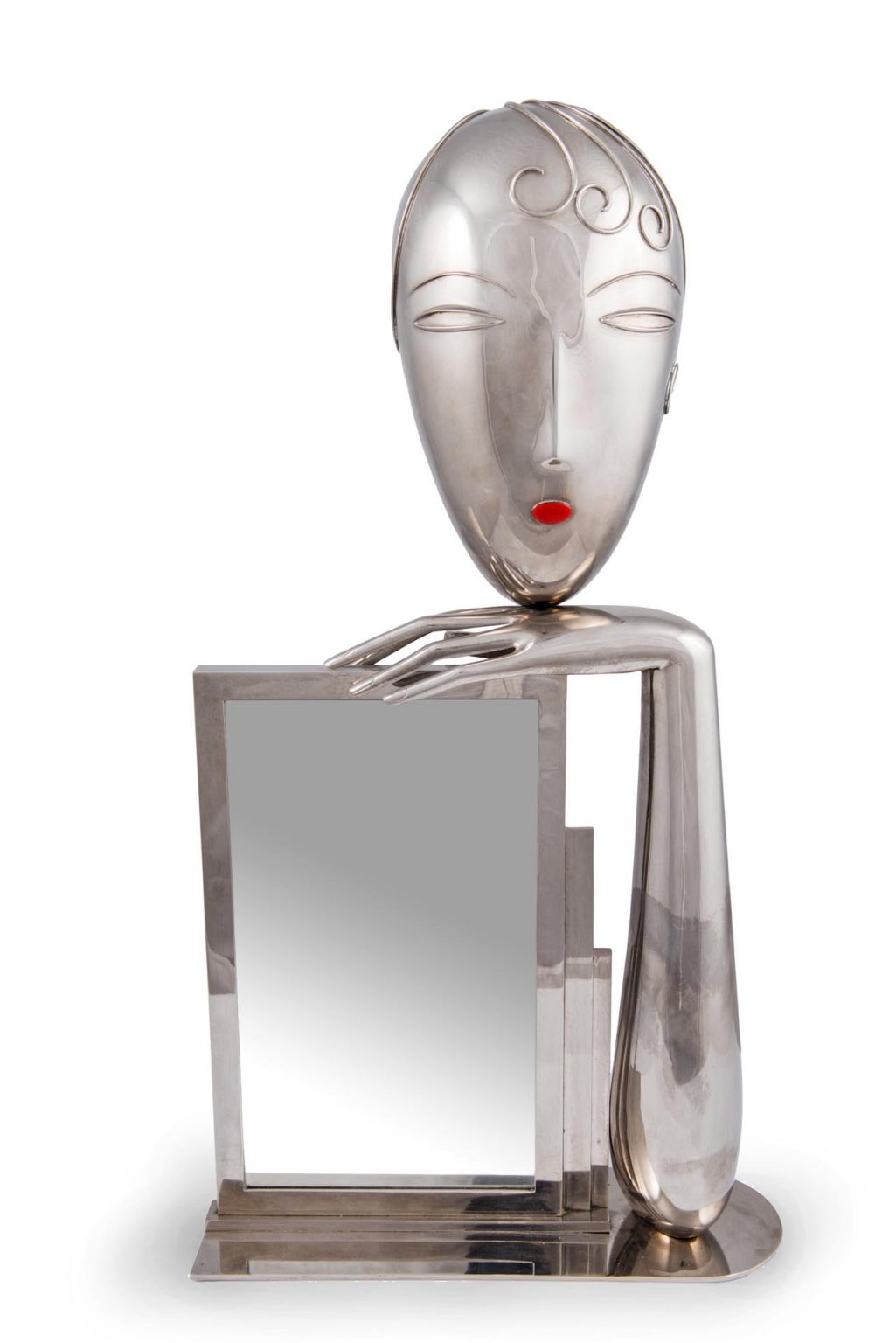
enamelled table mirror Franz Hagenauer ca. 1930
Werkstätte Hagenauer Wien
This table mirror with a hand and woman’s face is one of the most important designs from this period. The absolute reduction and the strongly reduced expression as well as the almost geometrical hand position are evidence of the revolutionary genius of the brothers Karl and Franz. The execution of the mirror is one of the highest quality works that we have ever had the pleasure of examining with objects by the Werkstätte Hagenauer. This object is certainly one of the most important and rarest figurative pieces by Hagenauer.
- table mirror
- design 1930s
- brass nickel plated, chased and mirror polished, enamelled
- height 59cm, width 30cm

A pair of head sculptures Franz Hagenauer ca. 1970
Werkstatte Hagenauer Wien
Among the most important works of Franz Hagenauer are without doubt the unmistakable depictions of human heads. Over the years, Hagenauer consolidated his style and the representations continued to develop until the 1980s. These two sculptures of a man and a woman date from this late period. Also a two-dimensional representation of human heads was not executed by Hagenauer until the 1980s. According to a statement by the last master craftsman of the Hagenauer company, these two heads were only executed once.
- brass, polished
- around 1980
- height 60 cm, width 41 cm, depth 15 cm

6 rare wine glasses designed by Otto Prutscher 1908 Wiener Werkstatte
Jugendstil
The design of these wine glasses dates from around 1907, one of the most creative periods of Prutscher’s career. As a pupil of Josef Hoffmann and Franz Matsch, he was responsible for many designs of the Wiener Werkstätte and Viennese residential buildings. The combination of square ornaments on the stem and in the cupola is typical of Prutscher’s designs. The glasses were extremely complex to make and a six-piece set of these wine glasses is a very rare find on the market.
- Design Otto Prutscher
- execution Meyr’s nephew, Adolf bei Winterberg, commission sale by the Wiener Werkstätte through the publisher E. Bakalowits Söhne
- around 1908.
- glass, mouth-blown, cut and ground, coloured
- H: 21 cm, DM: 8 cm
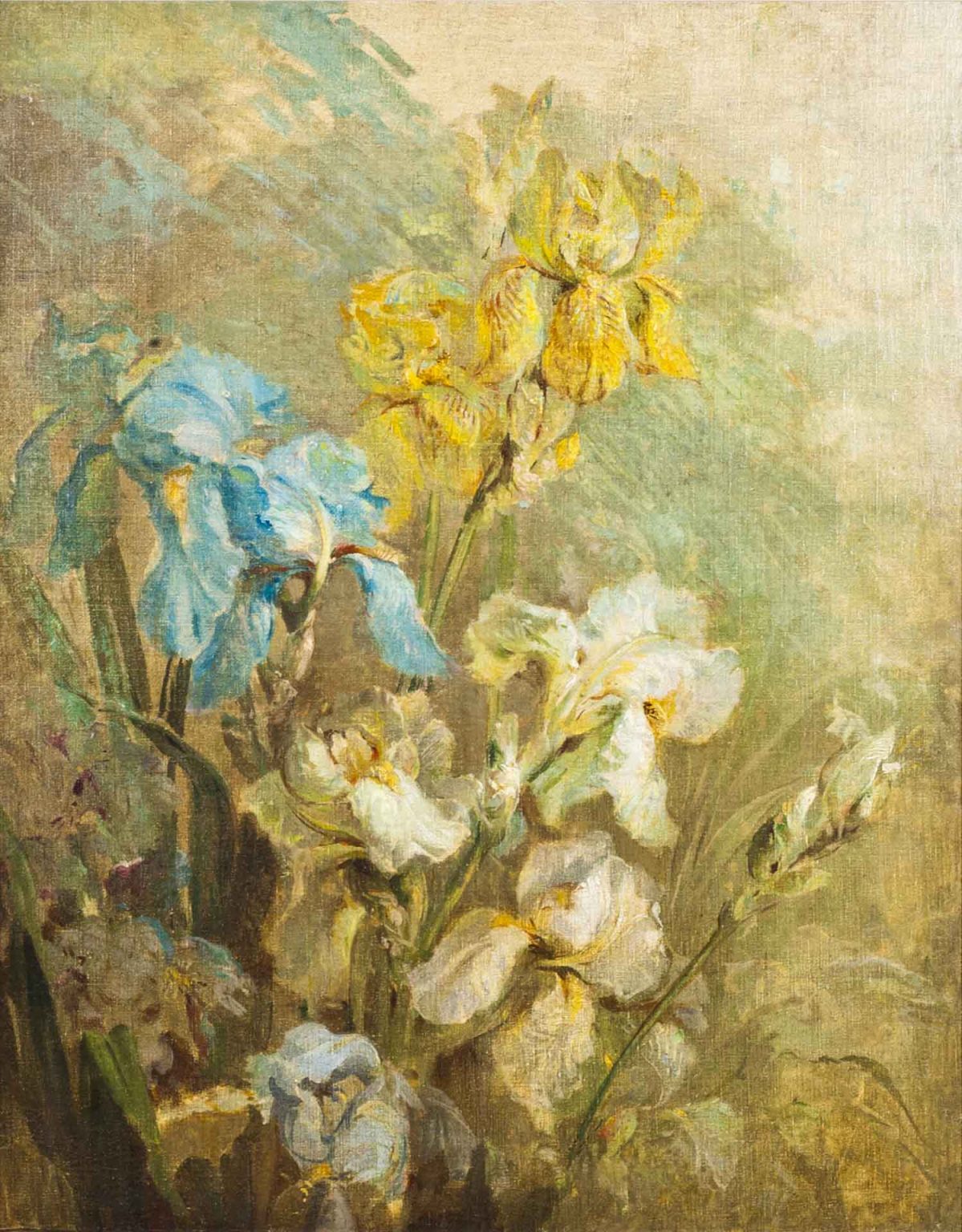
Goivanni Segantini "Schwertlilien" ca. 1890
Fine Art
Giovanni Segantini is considered one of the most important representatives of realistic symbolism and is often mentioned in the same breath as painters such as Edvard Munch, Vincent Van Gogh or Arnold Böcklin. Especially his landscape paintings enjoy an excellent reputation among collectors. Today, works by Giovanni Segantini are exhibited in major museums around the world, such as the Metropolitan Museum of Art, the Kunsthaus Zürich, the Kunstmuseum Basel, the Neue Pinakothek in Munich or the Belvedere in Vienna. Our flower still life shows the absolutely unmistakable painting technique and colour composition for Segantini and was celebrated as a sensation by the Italian specialist press.
- painted by Giovanni Segantini
- oil on canvas
- verso confirmed as genuine by the artist’s son

Armchair designed by Josef Urban for the 1st exhibition of the Hagenbund 1901
Furniture
This armchair was one of four identical pieces of furniture for the Hagenbund room at the VIII. International Art Exhibition in the Munich Glass Palace. On a contemporary illustration these four pieces of furniture are grouped around a column. After the exhibitions, the four armchairs became the private property of another member of the Hagenbund. The rose ornamentation was an essential design factor of the dining room in the villa of the painter Alexander Demetrius Golz and the frieze painted by Goltz himself shows exactly the same ornaments as the armchair. Noteworthy about this object are the elegant, clear lines and the clear affinity to works from the circle of the Glasgow School of Applied Arts around 1900. Such an object is a museum-like witness to one of the most important art epochs of our time.
- design Joseph Urban
- version 1901 for the department of the Hagenbund at the VIII. International Art Exhibition in the Munich Glass Palace
ornamentation retrofitted for the interior of the Villa Alexander - Goltz, Vienna XIX, Hohe Warte, Grinzingerstraße 87, after the demolition of the Villa Goltz private collection in Vienna
- maple wood, stained, original fabric cover, brass










